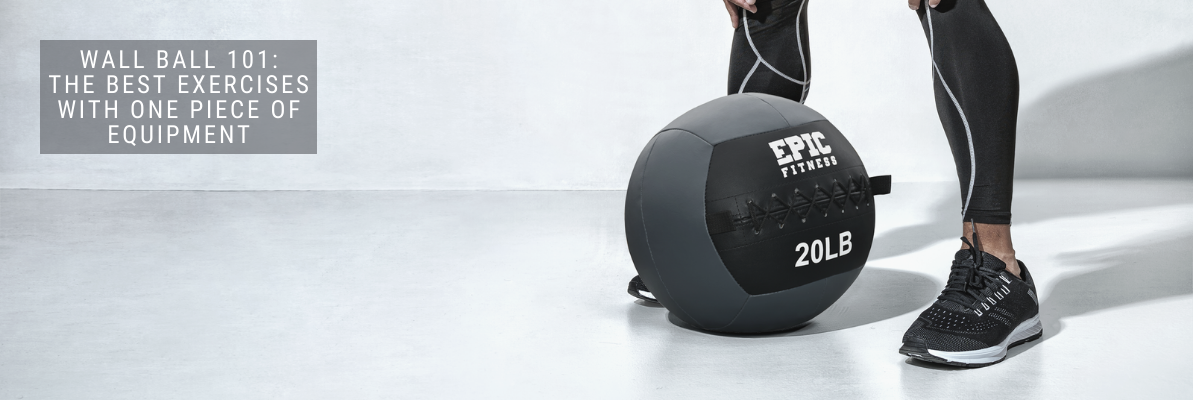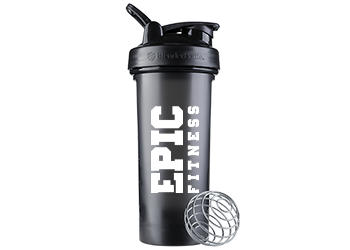
Why Wall Balls are one of the most versatile pieces of equipment
Wall balls are a unique gym tool that you can use for a wide variety of exercises. The shape of the wall ball makes it fantastic for explosive movements such as throwing, tosses, scoops, slams, and passes. The versatility of wall balls doesn't stop there. You can use them to load traditional exercises such as squats, hip-hinging movements, challenge upper body pushing exercises or integrate them into core training.
In this article, we’ll be overviewing several different wall ball exercise options. Each of these exercises can be integrated into a pre-existing workout or combined to create a circuit. Either way, the training effect is significant.
(Throughout the article, we’ll be using the terms “medicine ball” and “wall ball” interchangeably).

Benefits of Wall Ball Training
Medicine balls have been used to improve athleticism as far back as 1000 BC. Wall balls, a modern shift in the design of the medicine ball, are one of the best training tools for developing the ability to produce force. While it is essential to lift more weight and get stronger, increasing the speed at which we move an object is also critical.
Wall balls are the most versatile gym ball, as they are more forgiving to slam, throw and toss against walls and floors. Many people find walls balls to be more durable when compared to rubber medicine ball or slam ball.
Wall balls are weighted in various increments such as 8Lbs, 12Lbs, 16Lbs, 20Lbs, and 25Lbs. Unlike slam balls or medicine balls, wall balls have a soft shell around the weight. This allows the wall balls to be a perfect companion for partner workouts that involving tossing and catching. The cushioned weight absorbs the impact to reduce the risk for injury. The vegan leather covering is triple stitched and constructed to hold it's round shape after being tossed around. Slam balls, depending on the weight, can start to flop since they are filled solely with sand. Wall Balls are a uniform 14" diameter so you can securely hold the ball with your hands or feet in any position.
Here are a few key benefits to training with medicine balls:
- Train multiple planes of movement using the whole body
- Simple learning curve
- Versatile (strength, core, stability, power training, conditioning)
- Develop explosive power
- Rehabilitation tool after injuries
- Safe and forgiving to catch, hold and drop
- Soft enough to slam, toss, scoop and throw against walls and floors.
One great feature of wall balls is how quickly you can learn and start practicing in a wide variety of drills. The learning curve is minimal, and the exercises are limitless. Wall balls provide huge benefits while minimizing the opportunity for injury.
Many people think of core work while using wall balls, but they are a fantastic tool for building total body stability, power, and conditioning. Rotational throws and overhead scoops are two basic exercises that anyone can use to improve force production. The best part is these exercises have a wide variety of regressions and progressions. Use exercise regressions if you need to decrease the demands of an exercise or leverage exercise progressions to increase the challenge.
Let’s take a look at some of the exercises that can be performed with a wall ball.
EXPLOSIVE EXERCISES
Explosive wall ball movements are the equivalent of Olympic lifting for the core and upper body. Due to the shape of wall balls, they are still widely considered the best tool for training many explosive movements.
Many of these exercises do not require a wall to rebound the ball off of; however, if you have access to a cement wall or a wall sturdy enough to absorb the impact of a throw, you've just unlocked a whole host of high-performance exercises.
Hinged Chest Pass Rebounds
This exercise is performed in a hinged hip position with a chest pass aimed downward. In a situation where you may not have a wall capable of withstanding the impact of an upright chess pass, this exercise substitutes quite well.
Perform 3-5 sets of 8 repetitions. Each repetition should be maximum effort as you’re pressing the ball away from you aggressively
Overhead Slams
Overhead slams are a great core exercise that conditions the torso to produce power. So many core exercises lack power production; this one encourages it.
Begin with the ball overhead, arms fully extended at the elbows. Slam the ball into the floor, pulling hard with your lats and core. Flex the waist to 90° as you follow-through. Be sure to slam the medicine ball a few inches above your head to avoid any unexpected rebounding.
Perform 3 to 5 sets of 8 to 10 repetitions.
Alternating Split Stance Slams
The split stance decreases your support base as one leg steps backward while you drop down into a lunge. Try to time the slam of the ball with your descent down into the bottom of the lunge. This will test your balance.
Perform 3-5 sets of 6 repetitions on each side.
Rotational Toss (against a wall)
Rotational training is where it’s at! With rotation being undertrained, yet incredibly important for performance and function, this drill is fantastic. Ideally, you’ll have a wall or something sturdy to rebound the ball off of. Create a stable support base by separating the feet just outside shoulder width and flexing at the knees. Get aggressive with each throw!
Perform 3-5 sets of 6-8 repetitions on each side.
Alternating Square Stance Rotational Toss
Similar to the rotational toss above, except the chest will face the wall. Rebound the wall ball off the wall, switching sides on each throw.
Perform 3-5 sets of 8 repetitions on each side.
Wall Ball (aka squat-to-overhead throw)
Wall ball is one of the most recognizable medicine ball exercises. Stand 2 feet from the wall, squat down and launch the ball up into the air. Try to press the ball from 10-12 feet high and hit the same spot on the wall each time. Once you catch the ball, immediately drop down into the next squat and press. If you're doing wall ball correctly, the work is continuous. This creates a potent cardio training effect.
Aim for 2-3 sets of 15-20 repetitions. You can also perform this exercise for time.
Diagonal Lift (no throw)
Cross-body exercises are fantastic for building coordination and balancing performance. This exercise will have you start with the wall ball in a low position and finish in a high position on the opposite side of the body. The goal is to rip the ball from the near side hip through the far side shoulder with speed. Notice the bottom position includes a partial range of motion squat while the finish ends fully extension.
Perform 3-5 sets of 6-8 repetitions on each side.
Alternating Skater Jumps with Rotation (no throw)
This exercise combines lateral movement for the lower body, with rotation for the upper body. Focus on firmly planting the foot on each stride, while ripping the ball through the middle with force.
Perform 3-5 sets of 6 repetitions per side.
UPPER BODY EXERCISES
Integrating a wall ball into upper body exercises can increase the challenge and give bland exercise a facelift. Below are a few upper body pushing exercises worth exploring.
Hands-On Wall Ball Push-Ups
Place the hands firmly on the wall ball and lower down until your chest lightly touches the ball. Press back up. The narrower surface area of the wall ball will challenge your triceps and upper body stability.
Perform 3-5 sets of 8-10 repetitions.
Feet-On Wall Ball Push-Ups
Placing the feet on top of the wall ball does two things: it creates a balance challenge and elevates the feet above the hands, adding load to the push-up. Do your best to keep straight-line posture from the heel to the top of the head, and limit any jarring through the midsection as you perform the push-ups.
Perform 3-5 sets of 8-10 repetitions.
Alternating Rolling Wall Ball Push-Ups
This challenging push-up variation is all about timing, strength, and coordination. By placing one hand on top of the ball, you're asking the working arm to take on more load during the push-up. Rolling the ball from side to side introduces a timing and coordination component, which can provide a refreshing deviation away from traditional push-ups.
Perform 3-5 sets of 6-8 repetitions on each side.
LOWER BODY EXERCISES
The wall ball is not often used to challenge lower body exercises, yet it works exceptionally well. Exercises like squats and lunges can be loaded with a wall ball or made more difficult by adding rotation to the movement.
Reverse Lunge with Rotation
Adding a rotation to the traditional lunge exercise challenges the core, stability, and balance all at once. The key to this exercise is to rotate from the waist, spine acting like a swivel. Meaning, you don't want to be leaning to the right, to the left, forward, or backward as you rotate.
Timing is another key to this exercise. As you step back and lower the knee to the floor, perform the rotation. Try to accomplish this task all at once.
Single-Leg "Pistol" Squat
Pistol squats or a time-honored single-leg squat exercise is incredible for building strength. Once you've become efficient with bodyweight-only pistol squats, you must begin to add additional weight to challenge the movement. Traditionally, dumbbells and kettlebells are used to add load to pistol squat, but a wall ball can also be used.
Rep range and sets will vary from person to person, as this is not an easy exercise.
Perform 3-5 sets of 5-8 repetitions.
Rear Foot Elevated (RFE) Single-Leg Squats
Rearfoot elevated split squats are the perfect transition exercise when moving from two-legged squats into single-leg squats. The rear leg acts as a support mechanism and a rudder, while the front leg performs the work. Hug the wall ball close to your chest during the work sets.
Perform 3-5 sets of 8-10 repetitions.
Overhead Squat
Overhead squats are a test of mobility and stability. The key to overhead squats is to utilize a range of motion that you can control without compensating. Keep the arms straight at the elbows and the ball directly over the top of your head as you perform the squats. Do not rush this exercise. Slow down the tempo and actively pull yourself down to the floor.
Perform 3-5 sets of 10 repetitions.
CORE TRAINING CIRCUIT
Try performing these exercises in a circuit with little to no rest in between each. Perform eight repetitions of each exercise before moving onto the next. Rest for 75-90 seconds after completing one round. Aim to complete 3 rounds.
Hand-Foot-Hand Pass
Hanging Knee Raises
Superman (arms loaded)
Prone Hybrid Hamstring Curls
Going to give it a go? SHARE WITH US!
Show us on instagram and tag @shopepicfitness for a chance to be featured


